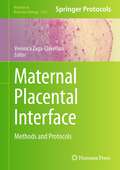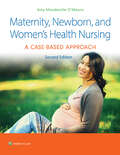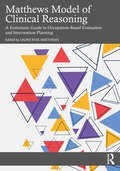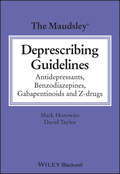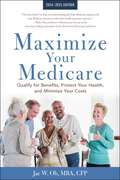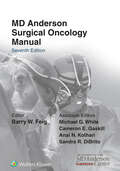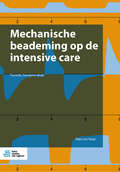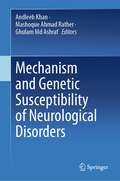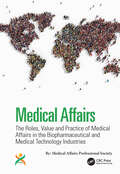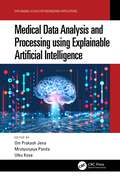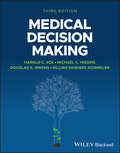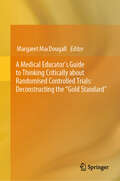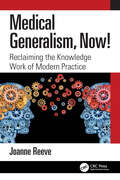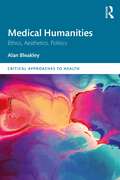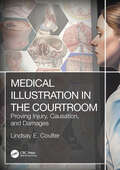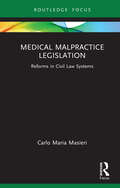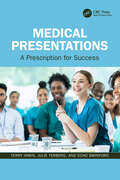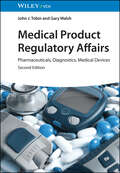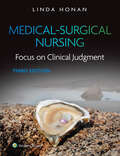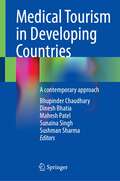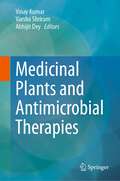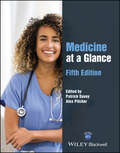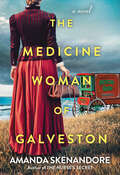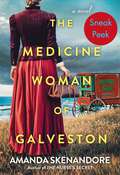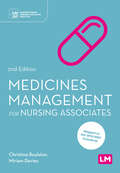- Table View
- List View
Maternal Placental Interface: Methods and Protocols (Methods in Molecular Biology #2781)
by Verónica Zaga-ClavellinaThis volume details critical and valuable experimental protocols to facilitate researchers in this fascinating field. Written in the highly successful Methods in Molecular Biology series format, chapters include introductions to their respective topics, lists of the necessary materials and reagents, step-by-step, readily reproducible laboratory protocols, and key tips on troubleshooting and avoiding known pitfalls. Authoritative and cutting-edge, Maternal Placental Interface: Methods and Protocols aims to ensure successful results in the further study of this vital field.
Maternity, Newborn, and Women's Health Nursing: A Case-Based Approach
by Amy O'MearaMaternity, Newborn, and Women’s Health Nursing: A Case-Based Approach, 2nd Edition presents realistic, patient-centered, case-based narratives that captivate students while instilling essential critical thinking skills and clinical judgment capabilities. 13 in-depth, unfolding case studies threaded throughout the text enrich students’ understanding of key concepts and align with the latest NCLEX® testing plan to prepare students for the challenges ahead in class, on their exams, and beyond. This updated 2nd Edition is enhanced with inclusive, bias-free language, robust essential nursing competency learning features, and the most current perspectives on care to help students ensure positive outcomes for an increasingly diverse patient population.
Matthews Model of Clinical Reasoning: A Systematic Guide to Occupation-Based Evaluation and Intervention Planning
by Laurie Knis-MatthewsThe Matthews Model of Clinical Reasoning (MMCR) provides occupational therapy practitioners with a systematic approach to develop their clinical reasoning skills during the evaluation and intervention process when collaborating with persons served across multiple practice locations. The three core constructs of person, environment, and occupation lay the foundation for practitioners to compartmentalize information from selected evaluations, determine relevant intervention priorities, implement occupation-based intervention plans, and interpret successful outcomes. This book, influenced by these constructs, the practice framework, and accreditation standards for academic preparedness, provides the reader with the foundational information on how to apply the core constructs using a MMCR systematic approach for evaluation and intervention. Within the chapters are a variety of instructional methods, interviews with practitioners of various levels of experience, and case study examples. Clinical reasoning guidesheets are presented to assist the reader to follow the MMCR clinical reasoning process in terms of evaluation findings, application of frame of reference (FOR)/practice models, intervention strategies, and documentation. Occupational therapy students and practitioners will be provided with the foundational skills to systematically think about and apply the steps of the clinical reasoning process, starting with a person’s evaluation through the completion of the intervention plan.
The Maudsley Deprescribing Guidelines: Antidepressants, Benzodiazepines, Gabapentinoids and Z-drugs (The Maudsley Prescribing Guidelines Series)
by Mark Horowitz David TaylorThe Maudsley® Deprescribing Guidelines Comprehensive resource describing guidelines for safely reducing or stopping (deprescribing) antidepressants, benzodiazepines, gabapentinoids and z-drugs for patients, including step-by-step guidance for all commonly used medications, covering common pitfalls, troubleshooting, supportive strategies, and more. Most formal guidance on psychiatric medication relates to starting or switching medications with minimal guidance on deprescribing medication. In 2023, the World Health Organisation and the United Nations called for patients, as a human right, to be informed of their right to discontinue treatment and to receive support to do so. The Maudsley Deprescribing Guidelines fills a significant gap in guidance for clinicians by providing comprehensive and authoritative information on this important aspect of treatment. This evidence-based handbook provides an overview of principles to be used in deprescribing. This is derived from fundamental scientific principles and the latest research on this topic, combined with emerging insights from clinical practice (including from patient experts). Building on the recognised brand of The Maudsley Prescribing Guidelines, and the prominence of the authors’ work, including in The Lancet Psychiatry on tapering antidepressants (the most read article across all Lancet titles when it was released). The Maudsley Deprescribing Guidelines covers topics such as: Why and when to deprescribe antidepressants, benzodiazepines, gabapentinoids and z-drugs Barriers and enablers to deprescribing including physical dependence, social circumstances, and knowledge about the discontinuation process Distinguishing withdrawal symptoms, such as poor mood, anxiety, insomnia, and a variety of physical symptoms from symptoms of the underlying disorder that medication was intended to treat The difference between physical dependence and addiction/substance use disorder Explanation of why and how to implement hyperbolic tapering in clinical practice Specific guidance on formulations of medication and techniques for making gradual reductions, including using liquid forms of medication, and other approaches Step-by-step guidance for safely stopping all commonly used antidepressants, benzodiazepines, gabapentinoids and z-drugs, including fast, moderate and slow tapering regimens or schedules for each drug, and guidance on how to tailor these to an individual Troubleshooting issues which can arise on stopping these medications, including akathisia, withdrawal symptoms, acute or protracted, and relapse. Written for anyone interested in safe deprescribing of psychiatric medications including psychiatrists, GPs, pharmacists, nurses, medical trainees, and interested members of the public. The Maudsley Deprescribing Guidelines is an essential resource on the subject that provides practical guidance on how to improve patient outcomes in this field of medicine.
Maximize Your Medicare: Qualify for Benefits, Protect Your Health, and Minimize Your Costs
by Jae Oh"Jae Oh&’s Maximize Your Medicare is the best book I&’ve read on understanding all of the Medicare options and how Medicare intersects with other health insurance options." —Wade Pfau, Professor of Retirement Income at The American CollegeIncludes the Most Up-to-Date Information for 2024-2025 Confused by Medicare? Get answers from Maximize Your Medicare, an informative guide by nationally recognized expert Jae W. Oh. Maximize Your Medicare helps readers understand how and what to choose when deciding on Medicare options. This book shows readers how to: Enroll in Medicare and avoid never-ending penalties Compare Medigap vs. Medicare Advantage Discern the differences among Parts A, B, and D Increase benefits every year Avoid costly errors Deal with special circumstances Get the most from the plan Additional information for this new edition includes: Putting it Together: the steps you need to take to be a Savvy Medicare Consumer New coverage options for Diabetes and End-Stage Renal Disease patients How the ACA enhancements can change your retirement decision-making path Written in a clear and concise style, Maximize Your Medicare is a vital resource for every American aged sixty-five or older, as well as for their families and care coordinators. ged sixty-five or older, as well as for their families and care coordinators.
The MD Anderson Surgical Oncology Manual
by Barry W FeigNow with additional review content and a larger page size, The MD Anderson Surgical Oncology Manual, Seventh Edition, focuses on multidisciplinary, cooperative management approaches to issues confronting today’s surgical oncologist. Lead editor Dr. Barry W. Feig is joined by recently graduated surgical oncology fellows Michael G. White, Cameron E. Gaskill, Anai N. Kothari, and Sandra R. DiBrito to bring you comprehensive yet concise information on the complete range of oncologic considerations needed to effectively understand cancer and all aspects of its treatment.
Mechanische beademing op de intensive care
by Hans ter HaarDit boek geeft een volledig en evidence-based overzicht van alle facetten van mechanische beademing. Het biedt de zorgprofessional inzicht in de verschillende beademingsvormen; de werkingsmechanismen, hoe ze optimaal kunnen worden toegepast, welke invloed ze uitoefenen op de longen en de rest van het lichaam en wat de gevolgen hiervan kunnen zijn. Mechanische beademing op de intensive care behandelt onder meer anatomie, fysiologie, pathofysiologie, respiratoire insufficiëntie, beademingsvormen, curves en loops, het instellen van de beademingsmachine, beademingsstrategieën en -technieken, complicaties en andere gevolgen, capnografie en ontwennen van beademing. Het boek gaat waar nodig diep op de materie in met inzichten uit de meest recente studies. Mede dankzij de vele afbeeldingen is het zeer leesbaar en toegankelijk.Nieuw in deze editie zijn onder andere Covid-19 ARDS, patient-self-inflicted-lung-injury, airway pressure release ventilation, mechanical power, gepersonaliseerd beademen, en nieuwe technieken om de mate van longstress te bepalen.Dit boek is een must voor iedereen die met mechanische beademing werkt, van IC-verpleegkundigen (in opleiding), beademingsspecialisten (in opleiding), tot artsen in opleiding en vele andere professionals die met mechanische beademing werken.Hans ter Haar is werkzaam als IC-verpleegkundige en beademingsspecialist in Isala Zwolle.
Mechanism and Genetic Susceptibility of Neurological Disorders
by Andleeb Khan Mashoque Ahmad Rather Ghulam Md AshrafThis book is about the "Mechanism and Genetic susceptibility of Neurological disorders. It is a comprehensive exploration, penned by esteemed authors, and offers a profound understanding of these enigmatic ailments, their progression, and the strategic approaches employed to mitigate their impact. In this book, readers will uncover a wealth of knowledge surrounding the mechanistic intricacies that underlie various neurological disorders. Through meticulous research and insightful analysis, the authors elucidate the inner workings of these conditions, shedding light on the mechanisms responsible for their onset and progression. The central themes of this book are the recognition of the genetic landscape governing neurological disorders. It emphasizes the role played by a diverse array of genes in the development and progression of these conditions, highlighting the multifaceted genetic susceptibility that underlies their manifestation.
Medical Affairs: The Roles, Value and Practice of Medical Affairs in the Biopharmaceutical and Medical Technology Industries
by Kirk Shepard, Charlotte Kremer, Garth SundemMedical Affairs is one of the three strategic pillars of the pharmaceutical and MedTech industries, but while clear career paths exist for Commercial and Research and Development, there is no formal training structure for Medical Affairs professionals. Medical and scientific expertise is a prerequisite for entry into the function, and many people transitioning into Medical Affairs have advanced degrees such as PhD, MD, or PharmD. However, these clinical/scientific experts may not be especially well-versed in aspects of industry such as the drug development lifecycle, crossfunctional collaborations within industry, and digital tools that are transforming the ways Medical Affairs generates and disseminates knowledge. This primer for aspiring and early-career Medical Affairs professionals equips readers with the baseline skills and understanding to excel across roles.Features: Defines the purpose and value of Medical Affairs and provides clear career paths for scientific experts seeking their place within the pharmaceutical and MedTech industries. Provides guideance and baseline competencies for roles within Medical Affairs including Medical Communications, Evidence Generation, Field Medical, Compliance, and many others. Specifies the "true north" of the Medical Affairs profession as ensuring patients receive maximum benefit from industry innovations including drugs, diagnostics and devices. Presents the purpose and specific roles of Medical Affairs roles across organization types including biotechs, small/medium/large pharma and device/diagnostic companies, taking into account adjustments in the practic of Medical Affairs to meet the needs of developing fields such as rare disease and gene therapy. Leverages the expertise of over 60 Medical Affairs leaders across companies, representing the first unified, global understanding of the Medical Affairs profession.
Medical Data Analysis and Processing using Explainable Artificial Intelligence (Explainable AI (XAI) for Engineering Applications)
by Om Prakash Jena Mrutyunjaya Panda Utku KoseThe text presents concepts of explainable artificial intelligence (XAI) in solving real world biomedical and healthcare problems. It will serve as an ideal reference text for graduate students and academic researchers in diverse fields of engineering including electrical, electronics and communication, computer, and biomedical. Presents explainable artificial intelligence (XAI) based machine analytics and deep learning in medical science. Discusses explainable artificial intelligence (XA)I with the Internet of Medical Things (IoMT) for healthcare applications. Covers algorithms, tools, and frameworks for explainable artificial intelligence on medical data. Explores the concepts of natural language processing and explainable artificial intelligence (XAI) on medical data processing. Discusses machine learning and deep learning scalability models in healthcare systems. This text focuses on data driven analysis and processing of advanced methods and techniques with the help of explainable artificial intelligence (XAI) algorithms. It covers machine learning, Internet of Things (IoT), and deep learning algorithms based on XAI techniques for medical data analysis and processing. The text will present different dimensions of XAI based computational intelligence applications. It will serve as an ideal reference text for graduate students and academic researchers in the fields of electrical engineering, electronics and communication engineering, computer engineering, and biomedical engineering.
Medical Decision Making
by Harold C. Sox Michael C. Higgins Douglas K. Owens Gillian Sanders SchmidlerMEDICAL DECISION MAKING Detailed resource showing how to best make medical decisions while incorporating clinical practice guidelines and decision support systems Sir William Osler, a legendary physician of an earlier era, once said, “Medicine is a science of uncertainty and an art of probability.” In Osler’s day, and now, decisions about treatment often cannot wait until the diagnosis is certain. Medical Decision Making is about how to make the best possible decision given that uncertainty. The book shows how to tailor decisions under uncertainty to achieve the best outcome based on published evidence, features of a patient’s illness, and the patient’s preferences. Medical Decision Making describes a powerful framework for helping clinicians and their patients reach decisions that lead to outcomes that the patient prefers. That framework contains the key principles of patient-centered decision-making in clinical practice. Since the first edition of Medical Decision Making in 1988, the authors have focused on explaining key concepts and illustrating them with clinical examples. For the Third Edition, every chapter has been revised and updated. Written by four distinguished and highly qualified authors, Medical Decision Making includes information on: How to consider the possible causes of a patient’s illness and decide on the probability of the most important diagnoses. How to measure the accuracy of a diagnostic test. How to help patients express their concerns about the risks that they face and how an illness may affect their lives. How to describe uncertainty about how an illness may change over time. How to construct and analyze decision trees. How to identify the threshold for doing a test or starting treatment How to apply these concepts to the design of practice guidelines and medical policy making. Medical Decision Making is a valuable resource for clinicians, medical trainees, and students of decision analysis who wish to fully understand and apply the principles of decision making to clinical practice.
A Medical Educator's Guide to Thinking Critically about Randomised Controlled Trials: Deconstructing the "Gold Standard"
by Margaret MacDougallDrawing on the statistical and philosophical expertise of its authors, this book is designed to improve understanding and use of randomised controlled trials (RCTs) among health professionals. It is intended for use primarily by medical educators involved in teaching statistics and evidence-based medicine (EBM) to medical students, junior doctors and other health professionals. However, each of the chapters serves a wider range of interests, including the practical needs of physicians in interpreting research evidence to support clinical decision making and the teaching needs of philosophers of medicine who want to more fully appreciate how RCTs work in practice and provide engaging examples for their students. Rather than compete with the proliferating methodological literature on RCT designs, this book focuses on cultivating a healthy skepticism among developing health professionals to support critical appraisal of their own and published work on RCTs at a fundamental level, including through a more informed understanding of the place of subgroup analyses in sound statistical inference. Management of the positive predictive value in the statistical analysis of RCT findings is included as an important topic for contemporary medical curricula. In comparing RCTs with non-randomised studies, a search for empirical evidence for the superiority of RCTs is initiated, pointing to the need for further work to confirm what form this evidence should take.Medical educators will find a wealth of reasons to encourage their students to think more critically about how the RCT operates in practice as a gold standard.
Medical Generalism, Now!: Reclaiming the Knowledge Work of Modern Practice
by Joanne ReeveMedical Generalism, Now! is a unique and timely consideration of generalist medical practice. With a focus on the knowledge work of clinical practice and by taking a whole healthcare system view, the book responds to a recognized need to strengthen generalist practice within modern healthcare delivery in both primary and secondary care settings. Through a series of creative provocations directed to consulting clinicians and their trainers/educators, service leaders and managers, and policy makers, readers are encouraged to challenge the orthodox view that generalism is an outdated 'jack of all trades’ sub-set of clinical medicine delivering the ‘simpler’ aspects of medicine, with more complex issues requiring onward specialist referral. Case studies are used throughout to illustrate the challenges to be faced, accompanied by a description of the principles of generalist knowledge work needed to tackle the scenarios described and discussing the implications for practice and service redesign. Essential reading for clinicians, managers and policy makers across all healthcare settings, the book concludes with a call to action, synthesizing the learning from each chapter to define and describe delivery of the key changes needed.
Medical Humanities: Ethics, Aesthetics, Politics (Critical Approaches to Health)
by Alan BleakleyThis ground-breaking book sets out a fresh vision for a future medical education by providing a radical reconceptualisation of the purposes of medical humanities through a lens of critical health psychology and liberatory pedagogy. The medical humanities are conceived as translational media through which reductive, instrumental biomedicine can be raised in quality, intensity, and complexity by embracing ethical, aesthetic, political, and transcendental values. This translation occurs through innovative use of metaphor. A note of caution is offered – that the medical humanities too can be instrumental and reductive if not framed well. Drawing on major theorists such as Michel Foucault and Jacques Rancière and bringing together insights from diverse but inter-related fields, Bleakley focuses on the "ills" of contemporary biomedicine and medical education, and the need for reconceptualisation, which – it is argued – the translational medical humanities have the potential to accomplish. Current instrumental approaches to medical humanities, embracing communication skills training and narrative-based medicine, have failed to address the chronic symptoms suffered by medicine. These include resort to closed, functional systems thinking rather than embracing dynamic, complex, open, and adaptive systems thinking; lack of democratic habits in medical culture, compromising patient safety and care; the production of insensibility rather than deepening of sensibility in medical education; a lack of attention to ethics, aesthetics, and politics where the instrumental is privileged; and a lack of critical reflexivity in revisioning habitual practices. Through persuasive argument, Bleakley sets out a more radical manifesto for the role the arts and humanities might play in medical/healthcare education and offers a new approach based on curriculum process rather than syllabus content, to recuperate aesthetic sensibilities, discernment, and affect in medicine. The book will appeal to medical and healthcare educators, medical and health humanities scholars, engaged clinicians, social scientists drawing on critical theory, and arts and humanities practitioners engaging with medical and healthcare themes.
Medical Illustration in the Courtroom: Proving Injury, Causation, and Damages
by Lindsay E. CoulterMedical Illustration in the Courtroom: Proving Injury, Causation, and Damages educates the reader on how to communicate science visually—in personal injury, medical malpractice, criminal, and forensic cases—by creating art that utilizes medical records, radiographs, and computer software. Medical illustration bridges the gap between complex technical, medical, and scientific concepts to clearly illustrate, and explain visually, a medical condition, negligence, or the causation of an injury or death to the lay person. Medical artists are frequently challenged with illustrating injuries and medical conditions that can’t be seen by the naked eye. And while using medical photography and imaging for illustrative purposes can be helpful, to an untrained eye it can often be unclear or confusing. This is where the medical illustrator enters the equation. There are often patients who have recovered from an injury or infection that appear in good health. However, should an unforeseen injury or fatality happen, medical illustrators can reveal to people what’s actually going on inside the person, an invaluable asset to attorneys in the courtroom—especially for personal injury and medical malpractice cases. While many attorneys utilize medical artists, nonvisual people don’t always recognize the value of demonstrative aids until they see them first-hand.When attorneys and their clients enlist the aid of medical artists, it quickly becomes apparent that properly conceived and executed artwork is invaluable to illustrating the facts—and medical impacts—of any number of scenarios: homicides by shooting, stabbings, vehicular accidents, in addition to medical malpractice and personal injuries resulting from surgery or possible negligence.Presenting a myriad of services and computer technologies that can be utilized, Medical Illustration in the Courtroom provides demonstrative aids used in cases to illustrate personal injury and medical malpractice, employing "tricks of the trade" to create an accurate effective image. Such images are educational to attorneys, insurance adjusters, judges, and juries to help create a visual storyline, the goal being to help combine art and science to provide a clear illustration of events to help in adjudicate legal and forensic cases.
Medical Malpractice Legislation: Reforms in Civil Law Systems (Young Feltrinelli Prize in the Moral Sciences)
by Carlo Maria MasieriThis book aims to analyse the legal tools that the legislatures of France, Germany and Italy adopted in order to regulate medical malpractice.In the mid-1970s, a reform movement started in the United States, where there was considerable concern about then ongoing medical malpractice crises. Since the beginning of the current century, France, Germany and Italy have passed statutes that aim to reform medical liability rules. Thus, it is first interesting to assess whether any medical malpractice crises have been identified in these systems and, second, how these have been faced through the passing of new statutes on the continent. Accordingly, the first chapter explores the idea of medical malpractice crisis and its relationship with the insurance market, also considering the reflections of American scholars. It then reconstructs the French, German and Italian legal frameworks, as well as their insurance and litigation contexts, reviewing and commenting on the quantitative evidence that was collected before the reforms. The second chapter briefly summarises the debate on medical malpractice reforms in France, Germany and Italy. It then analyses the statutes that have been passed, distinguishing between reforms that consolidate case law and reforms that introduce innovative solutions, sometimes repealing court-developed doctrines. In particular, the chapter examines in a comparative perspective the diff erent options adopted in these civil law countries with regard to the rules on liability, burden of proof, statute of limitations and damages. Moreover, the chapter examines the reforms of insurance, procedural and evidence law, to the extent they affect medical malpractice cases. The third chapter reviews and analyses the current available data related to medical malpractice litigation and insurance after the reforms adopted in France, Germany and Italy, in order to find out evidence of their effectiveness and efficiency. It also highlights some aspects of medical malpractice law that still belong to the domain of the judiciary. It finally points out which problems may be addressed by the legislatures and what further data should be collected in the future.This work may interest legal scholars, healthcare providers, insurers and policymakers.
Medical Presentations: A Prescription for Success
by Terry Irwin Julie Terberg Echo Swinford“A comprehensive guide to planning, constructing, and delivering presentations. This is the missing manual that every doctor needs”.Rowan Parks, Professor of Surgical Sciences and Honorary Consultant Surgeon,University of Edinburgh; President of Royal College of Surgeons of Edinburgh“A fantastic, fool proof guide to presenting like a pro!”Alice Roberts, Professor of Public Engagement in Science, University of Birmingham; Broadcaster and AuthorThis book will teach healthcare professionals how to craft more effective and engaging PowerPoint® presentations, taking readers through the preparation of a presentation from concept to delivery. The book is based on decades of the authors’ personal experiences teaching PowerPoint® and slide design. The text is based on a sound understanding of educational theory. Readers will learn how to present interesting and visually appealing slides. In particular, the focus will be on designing professional-looking slides that convey a clear and memorable message.The book will be valuable to any healthcare professional required to put together presentations, whether a high-flying academic doctor or nurse presenting their research at international conferences, a trainee giving a talk at an in-house educational session, or a student preparing a presentation as part of their course work.
Medical Product Regulatory Affairs: Pharmaceuticals, Diagnostics, Medical Devices
by John J. Tobin Gary WalshMedical Product Regulatory Affairs Hands-on guide through the jungle of medical regulatory affairs for every professional involved in bringing new products to market Based on a module prepared by the authors for an MSc course offered by the University of Limerick, Ireland, Medical Product Regulatory Affairs is a comprehensive and practical guide on how pharmaceutical and medical devices are regulated within the major global markets. The Second Edition builds on the success of the first with an even wider scope and full coverage of new EU regulations on the safe use of medical devices. Following a look at drug development, complete sections are devoted to national and EU regulatory issues, manufacturing license application and retention, and regulation in the USA. Other topics dealt with include CDER, CBER and marketing and manufacturing licenses, the ICH process and Good Laboratory/Clinical/ Manufacturing Practices. Medical Product Regulatory Affairs includes information on: Aims and structure of regulation, covering purpose and principles of regulation, national and EU legislative processes, and pharmacopeia Regulatory strategy, covering product development and manufacturing, market vigilance, quality assurance systems, personnel, and documentation Drug discovery and development, covering prescription status, physical properties, therapeutic use, and drug discovery, development, and delivery Non-clinical studies, covering non-clinical study objectives and timing, pharmacological and pharmacodynamic studies, and bioavailability and bioequivalence Clinical trials, covering trial protocol, monitoring of trials, trial master files, and FDA communications The wide coverage of different product types and the main global markets makes Medical Product Regulatory Affairs ideal for training courses on regulatory affairs in academia and industry. It is also a valuable reference for pharmacologists, bioengineers, pharma engineers, and students in pharmacy to familiarize themselves with the topic.
Medical-Surgical Nursing: Focus on Clinical Judgment
by Linda HonanConfidently meet the demands of transitioning students into practice-ready nurses with Medical-Surgical Nursing: Focus on Clinical Judgment, 3rd Edition. Expertly curated by experienced clinician and nursing educator Dr. Linda Honan, this practical approach distills complex concepts down to need-to-know details through the perspective of practicing nurses, establishing a comprehensive foundation in medical-surgical nursing by way of the most commonly encountered conditions and situations. Extensive updates throughout this 3rd Edition broaden your students’ perspectives, cultivate their clinical judgment, and prepare them for success from the Next Generation NCLEX® to the day-to-day challenges of today’s medical-surgical nursing practice.
Medical Tourism in Developing Countries: A contemporary approach
by Bhupinder Chaudhary Dinesh Bhatia Mahesh Patel Sunaina Singh Sushman SharmaThis book provides a detailed insight into the amalgamation of the healthcare and hospitality sector, which brought forward the concept of healthcare tourism or medical tourism. There have not been comprehensive resources in this particular area. The available quality resources focus on the Western world. Countries like India are an upcoming and one of the most favored destinations for medical tourism, and this trend is going to increase exponentially in the coming years. This book is developed in a very simple and lucid manner to enable even a layman to grasp the key components of the healthcare and hospitality sector at different levels and gradually link it to the present scenario where factors like accreditation, health insurance, corporatization, and public policy make an impact. Scholars in these sectors attempt to provide the recent trends and prospects supported with updated information. Therefore, it can solve the problem of a single source of detailed information relevant to different yet interconnected industries with a focus on developing countries.
Medicinal Plants and Antimicrobial Therapies
by Vinay Kumar Varsha Shriram Abhijit DeyThis book serves as an excellent comprehensive material covering the current understandings and updates on antimicrobial resistance (AMR) and the use of medicinal plant resources for tackling it. Chapters cover important aspects of AMR and strategies to address this threatening issue with medicinal plants and their resources. One health perspectives for addressing AMR have been presented for the readers. Antimicrobial medicinal plant therapeutic resources including crude extracts, active fractions, pure molecules and essential oils, besides using them as functionalizing agents for nano-antimicrobials have been covered. Further, plant endophytes as a source of antimicrobial compounds have been discussed. Chapters cover both the bactericidal as well as resistance-reversal (or potentiating/ combinatorial therapies) potencies of medicinal plant resources. The book also focuses on how medicinal plant resources effectively target major determinants of AMR. Use of metabolomics in understanding and targeting AMR mechanisms and identifying potent phyto-therapeutics has been discussed as well. The book is a valuable read for both experienced and younger researchers working in the field of AMR and related fields in biomedicine, pharmacy, and clinical research.
Medicine at a Glance (At a Glance)
by Patrick Davey Alex PitcherMedicine at a Glance The market‐leading at a Glance series is popular among healthcare students and newly qualified practitioners for its concise and simple approach and excellent illustrations. Each bite‐sized chapter is covered in a double‐page spread with clear, easy‐to‐follow diagrams, supported by succinct explanatory text. Covering a wide range of topics, books in the at a Glance series are ideal as introductory texts for teaching, learning and revision, and are useful throughout university and beyond. Everything you need to know about Medicine… at a Glance! Discover a fully updated and comprehensive revision guide for the core medical curriculum In the newly revised Fifth Edition of Medicine at a Glance, expert general physicians and cardiologists, Dr Patrick Davey and Dr Alex Pitcher, deliver a fully updated and comprehensive overview of the core medical curriculum. All topics are presented in an intuitive, double-page spread style with four-colour illustrations included to aid in learning and retention. The book is an essential tool for medical students revising for exams and an excellent reference for those on clinical attachments. The Fifth Edition includes expanded coverage of COVID, neurology, fluid management, and medical emergencies. As the perfect practical companion for medical students for on-the-go study and review, Medicine at a Glance offers access to a companion website and a bundled “Core Cases” book. Every bite-sized chapter is supported by clear, easy-to-follow diagrams and succinct explanatory text. The book also offers: A thorough introduction to the practice of medicine generally and how to be a medical student, including discussions of patient confidentiality and consent, patient relationships, complaint history, medical history, and the principles of examination Comprehensive explorations of clinical presentations at a glance, including cardiovascular disease, respiratory disease, renal medicine, and more Practical discussions of diseases and treatments at a glance, including endocrinology, infectious disease, haematology, and more In-depth examinations of miscellaneous medical issues, including fluid replacement therapy, psychiatric disorders, and substance misuse Perfect for medical students, Foundation Programme Doctors, and Physician Associates, Medicine at a Glance is also an indispensable resource for anyone training in the allied health professions seeking a fully updated and comprehensive clinical medicine revision guide.
The Medicine Woman of Galveston
by Amanda SkenandoreA downtrodden female doctor takes up with a traveling medicine show to support her disabled son, joining a German giantess, a bowlegged musician, an indentured Creek poet, and a handsome tinker under the thumb of a charismatic but menacing swindler on a collision course with the deadliest natural disaster in American history – the Galveston Hurricane of 1900. Readers of Christina Baker Kline, Sandra Dallas, and Sara Donati will be captivated by this story of medical historical fiction by Amanda Skenandore, registered nurse and acclaimed author of The Nurse&’s Secret and The Second Life of Mirielle West. Once a trailblazer in the field of medicine, Dr. Tucia Hatherley hasn&’t touched a scalpel or stethoscope since she made a fatal mistake in the operating theater. Instead, she works in a corset factory, striving to earn enough to support her disabled son. When even that livelihood is threatened, Tucia is left with one option—to join a wily, charismatic showman named Huey and become part of his traveling medicine show. Her medical license lends the show a pretense of credibility, but the cures and tonics Tucia is forced to peddle are little more than purgatives and bathwater. Loathing the duplicity, even as she finds uneasy kinship with the other misfit performers, Tucia vows to leave as soon as her debts are paid and start a new life with her son—if Huey will ever let her go. When the show reaches Galveston, Texas, Tucia tries to break free from Huey, only to be pulled even deeper into his schemes. But there is a far greater reckoning ahead, as a September storm becomes a devastating hurricane that will decimate the Gulf Coast—and challenge Tucia to recover her belief in medicine, in the goodness of others—and in herself.
The Medicine Woman of Galveston: Sneak Peek
by Amanda SkenandoreBe one of the first to read this sneak preview sample edition!Caught in the great Galveston Hurricane of 1900, a female doctor who&’s joined a traveling medicine show to support her disabled son is forced to weather the storm and its aftermath in a town hostile to the troupe&’s unconventional ways but desperate for their help. Readers of Ellen Marie Wiseman, Sandra Dallas, and Sara Donati will be captivated by this story of medical historical fiction by Amanda Skenandore, registered nurse and acclaimed author of The Nurse&’s Secret and The Second Life of Mirielle West.Once a trailblazer in the field of medicine, Dr. Tucia Hatherley hasn&’t touched a scalpel or stethoscope since she made a fatal mistake in the operating theater. Instead, she works in a corset factory, striving to earn enough to support her disabled son. When even that livelihood is threatened, Tucia is left with one option—to join a wily, charismatic showman named Huey and become part of his traveling medicine show.Her medical license lends the show a pretense of credibility, but the cures and tonics Tucia is forced to peddle are little more than purgatives and bathwater. Loathing the duplicity, even as she finds uneasy kinship with the other misfit performers, Tucia vows to leave as soon as her debts are paid and start a new life with her son—if Huey will ever let her go.When the show reaches Galveston, Texas, Tucia tries to break free from Huey, only to be pulled even deeper into his schemes. But there is a far greater reckoning ahead, as a September storm becomes a devastating hurricane that will decimate the Gulf Coast—and challenge Tucia to recover her belief in medicine, in the goodness of others—and in herself.
Medicines Management for Nursing Associates (Understanding Nursing Associate Practice)
by Christina Roulston Miriam DaviesThe first medicines management textbook for trainee nursing associates! Effectively managing and administering medicines is a core responsibility for all nursing associates. This book covers everything a trainee nursing associate needs to master, from understanding the fundamental legal and professional requirements to developing essential drug calculations skills. This often-overwhelming subject is broken down into manageable chunks, with students taken step-by-step through the theory before practicing what they’ve learnt with the help of insightful case studies and activities. Key features: Written specifically to address the unique experiences, challenges and requirements of the nursing associate role and fully mapped to the NMC standards of proficiency (2018). Activities help trainees get to grips with the key skills and responsibilities of the role and allow them to practice calculations. Wide-ranging case studies cover all fields and a variety of clinical settings to show how this knowledge applies to practice. ABOUT THE SERIES: The Understanding Nursing Associate Practice series (UNAP) is a new collection of books uniquely designed to support trainee nursing associates throughout their training and into a professional career.
